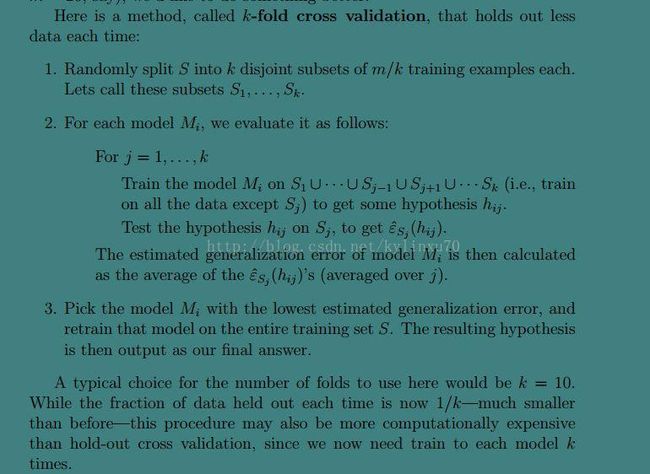关于K-fold cross validation 下不同的K的选择的疑惑?
在K-fold cross validation 下 比较不同的K的选择对于参数选择(模型参数,CV意义下的估计的泛化误差)以及实际泛化误差的影响。更一般的问题,在实际模型选择问题中,选择几重交叉验证比较合适?
交叉验证的背景知识:
CV是用来验证模型假设(hypothesis)性能的一种统计分析方法,基本思想是在某种意义下将原始数据进行分组,一部分作为训练集,一部分作为验证集,使用训练集对每个hypothesis进行训练,再用验证集对每个hypothesis的性能进行评估,然后选取性能最好的hypothesis作为问题对应的模型。
常用CV 方法:
1. Hold-out method
最简单的验证方法,将训练数据随机分为两份(典型做法是七三分)。不是真正意义上的CV,没有交叉的思想,所以验证集上的测试精度与原始数据的分组有很大关系,具有随机性,不具有说服性。(是否可通过多次平均的方法来消除这种随机性?待验证)
2. K-fold CV
一般,k>=2。经验上,k取5即可(计算量与精度的权衡),k=5时的结果大致和10以上类似。
3. Leave-one-out CV(LOO-CV)
K-fold CV 的极端情况,将k设为样本数。
优点:(1)结果可靠。
(2)实验过程可被复制。
缺点:计算量过大。实际操作困难,除非并行化。
实验: 使用高斯核最小二乘做回归。
Code:
Contents
- training set
- test set
- ================Cross Validation=======================
- ================ Normal Equations ================
training set
the number of the tarining samples
trainSize=1000; % the dimension of the tarining samples trainDim=1; % the gaussian noise (u=0, sigma= 0.4472(variance equals to 0.2)) % epsilon=normrnd(0, 0.4472,trainSize,trainDim); % the gaussian noise (u=0, sigma= 0.3162(variance equals to 0.1)) % epsilon=normrnd(0, 0.3162,trainSize,trainDim); epsilon=normrnd(0, 0.1,trainSize,trainDim); % the nosiy training samples % the uniform distribution in [-a,a] % R = a - 2*a*rand(m,n) % x_train=1-2.*rand(trainSize,trainDim); %[-1,1] x_train=pi-(2*pi).*rand(trainSize,trainDim); %[-pi,pi] % sinc target function y_train=sinc(x_train)+epsilon; %y_train=sinc(x_train);
test set
the number of the test samples
testSize=1000; % the dimension of the tarining samples testDim=1; % the test samples x_test=pi-2*pi.*rand(testSize,testDim); y_test=sinc(x_test);
================Cross Validation=======================
[mse,bestk,bestg] = RLScgForRegress(x_train,y_train);
================ Normal Equations ================
fprintf('Solving with normal equations...\n'); D_train=generateDictonary(x_train,x_train,bestg); D_test=generateDictonary(x_test,x_train,bestg); % Map D_train onto Guassian high-dim Features and Normalize [D_train, mu, sigma] = featureNormalize(D_train); % Map D_test and normalize (using mu and sigma) D_test = bsxfun(@minus, D_test, mu); D_test = bsxfun(@rdivide, D_test, sigma); % Calculate the parameters from the normal equation ntheta = normalEqn(D_train,y_train,bestk); % % Display normal equation's result % fprintf('Theta computed from the normal equations: \n'); % fprintf(' %f \n', ntheta); % fprintf('\n'); trainError=sqrt(sum((y_train-D_train*ntheta).^2)/size(y_train,1)); testError=sqrt(sum((y_test-D_test*ntheta).^2)/size(y_test,1)); % Plot fit over the data figure; plot(x_test, y_test, 'rx', 'MarkerSize', 10, 'LineWidth', 1.5); xlabel('x test'); ylabel('y test'); hold on; grid on; plot(x_test,D_test*ntheta, 'b.', 'LineWidth', 2); hold off;
对于这个问题,选择K为多少比较合适?
1、 首先确定待选模型参数的范围(即假设空间),确保所选范围能包含最优假设。K-fold CV 可以选出某种意义下的最优的参数,但通过实验观察,似乎的趋势是,不同的K对应的假设空间是不同的,K越大,需要增加参数的区间,以保证假设空间能包含住最优性能的假设。
Eg:lambda_vec = [0.001 0.003 0.01 0.03 0.1 0.3 1 1.3 1.6 1.9 2.3 3 6 10 20 40 70 100 150 200 250 300];
sigma_vec = [0.03 0.1 0.3 1 1.3 1.6];
这两组参数区间下,对应的假设的性能:
2、 对于不同的K对应的CV的评价指标:
(1)CV意义下的估计泛化误差(使用RMSE)
(2)实际泛化误差
K=2时
最优估计泛化误差 0.1832 实际泛化误差 0.1769
K=5时
最优估计泛化误差 0.2011 实际泛化误差 0.2571
K=10时
最优估计泛化误差 0.2020 实际泛化误差 0.2740
这种随着K增加,泛化误差增加的趋势和理论上不符?
理论上,随着K越大,可供训练的样本更多,这样评估的结果更可靠。即是这两种泛化误差都应是下降趋势。





